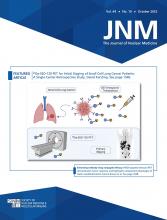REPLY: We very much would like to thank Dr. Bailey for his valuable comments, which give us the opportunity to further explain our definition of theranostics.
Dr. Bailey writes that a meaningful definition of theranostics requires that the targeting moiety be the same or very similar for the imaging agent and the therapeutic agent. We are not sure if this is a reasonable requirement. For example, amyloid imaging agents are small molecules, whereas the therapeutics are full-size antibodies. Nevertheless, the identical molecular target is addressed, and the use of amyloid PET imaging to select patients for amyloid antibody therapy seems to be a perfect example of a theranostic approach. Conversely, minor chemical changes in a peptide can fundamentally alter its binding affinities. For example, somatostatin receptor antagonists are highly sensitive to N-terminal modifications of the peptide chain. As a consequence, the somatostatin receptor antagonist DOTA-JR11 has a more than 10-fold lower binding affinity when labeled with 68Ga than when labeled with 177Lu (1). Consequently, the combination of 68Ga-DOTA-JR11/177Lu-DOTA-JR11 is not an ideal theranostic pair (2). A better companion diagnostic for 177Lu-DOTA-JR11 is 68Ga-NODAGA-JR11, that is, a compound that is chemically less similar to 177Lu-DOTA-JR11 than is 68Ga-DOTA-JR11 (3).
Because similar molecules may be poor theranostic pairs and very different molecules may be excellent theranostic pairs, we do not think that the definition of theranostic agents should require that the imaging agent and the therapeutic agent be identical or very similar. A better definition may be that the imaging agent and the diagnostic agent have an identical target.
One can have different opinions on the question of whether the definition of theranostic imaging should be made even wider. We have argued in our article that the definition should be broad, especially for the development of new imaging agents. Imaging agents that are companion diagnostics for a specific therapy have a clear path for regulatory approval and reimbursement because they have an obvious impact on patient management. Whether one should use the term theranostic or companion diagnostic for this use of imaging can be debated. We would prefer theranostic because the term companion diagnostic is already broadly used for blood- or tissue-based biomarkers.
However, we would caution on use of the term gatekeeper to refer to theranostics or companion diagnostics. In fact, we believe that a theranostic imaging agent is the opposite of a gatekeeper—which limits therapeutic options—but rather is a facilitator that creates new opportunities to treat patients. In other words, no theranostic is a gatekeeper. We of course realize that this is often a matter of perspective: a theranostic agent that images the expression of a target for radiopharmaceutical therapy can be seen as a test that facilitates this therapy or as a gatekeeper that prevents an ineffective therapy in a patient who does not express the target. However, in other instances theranostic imaging clearly enables new therapies, for example, by detecting the site of recurrence in a patient with an elevated tumor marker. Therefore, we believe that theranostic imaging should be viewed as a facilitator, not a gatekeeper.
In conclusion, we appreciate the opportunity to further clarify our definition of theranostics and would maintain that theranostics is “a combination of imaging and therapy in which imaging provides actionable information that enables new or more effective therapies.” (4)
Wolfgang Andreas Weber*, Henryk Barthel, Frank M. Bengel, Matthias M. Eiber, Ken Herrmann, Michael Schäfers
*Technical University of Munich, Munich, Germany
E-mail: w.weber{at}tum.de
Footnotes
Published online Jun. 29, 2023.
- © 2023 by the Society of Nuclear Medicine and Molecular Imaging.
REFERENCES
- Received for publication May 23, 2023.
- Revision received May 31, 2023.







